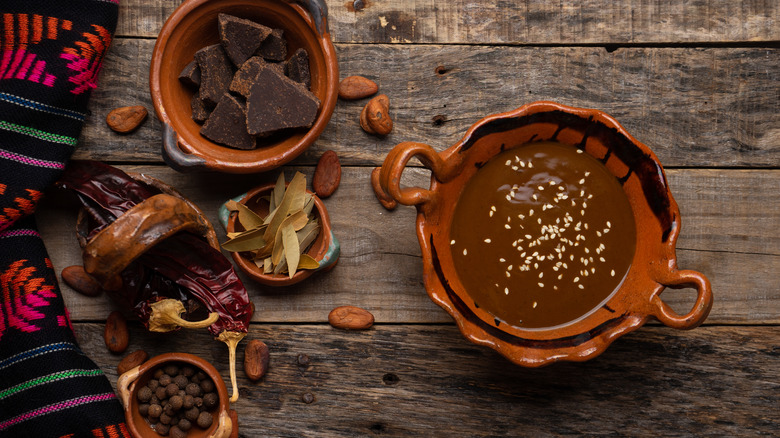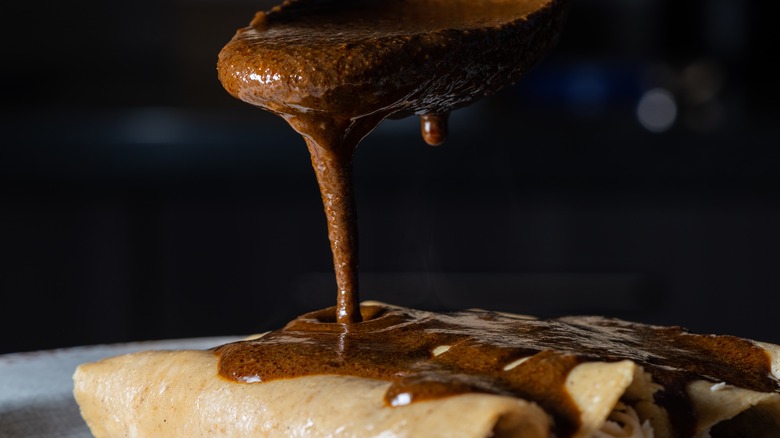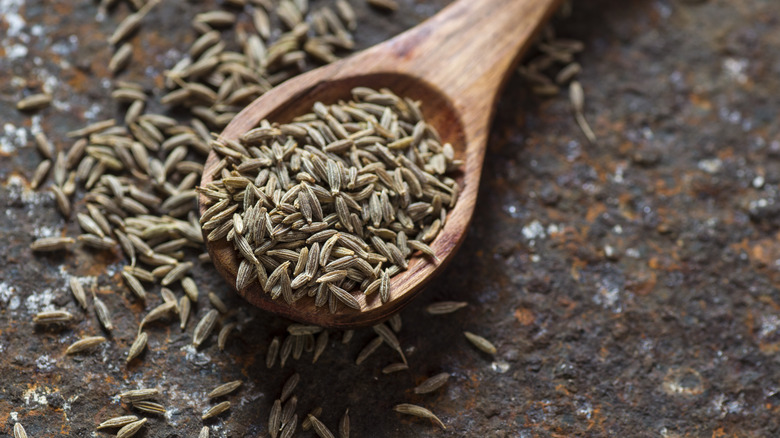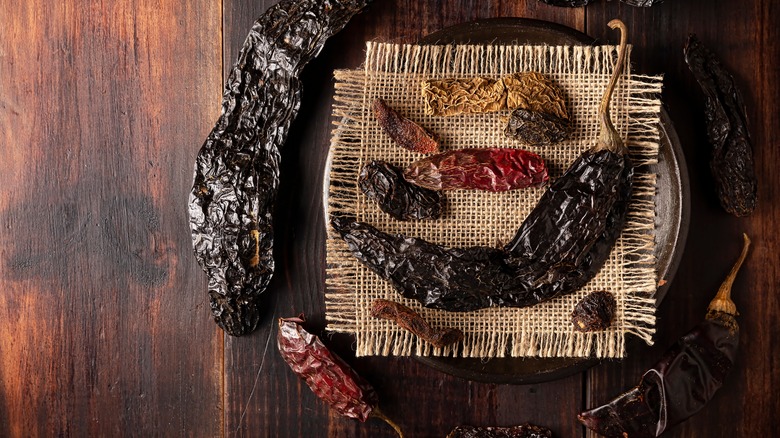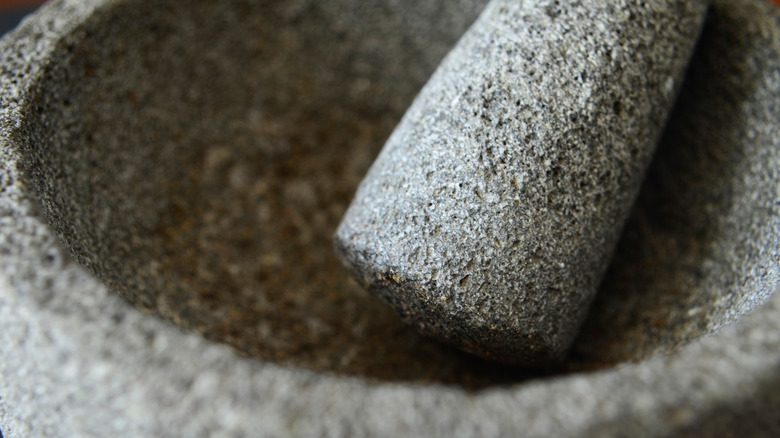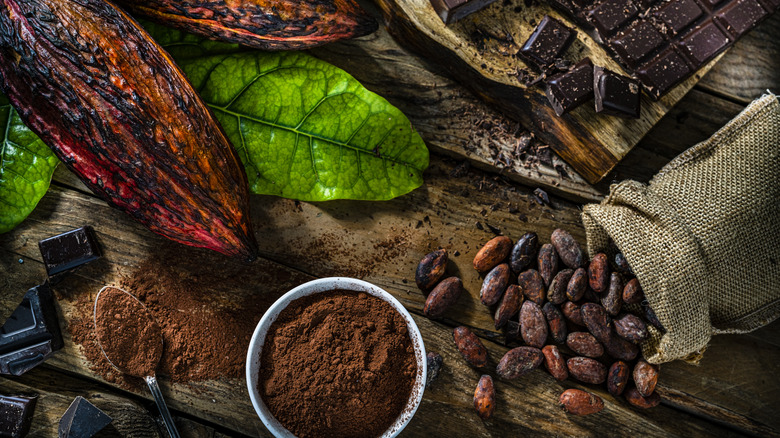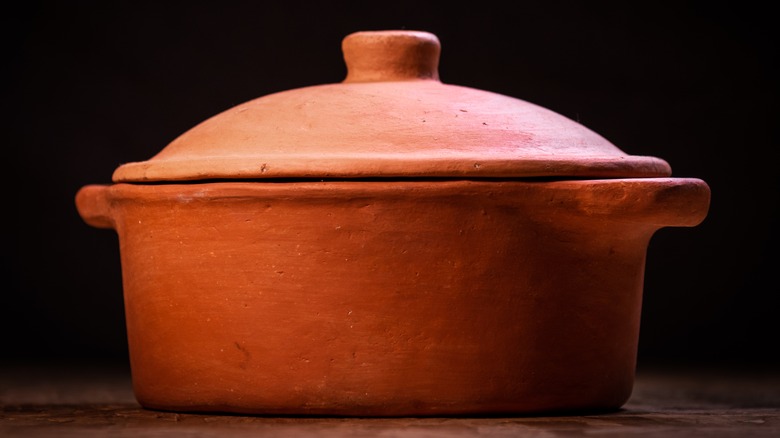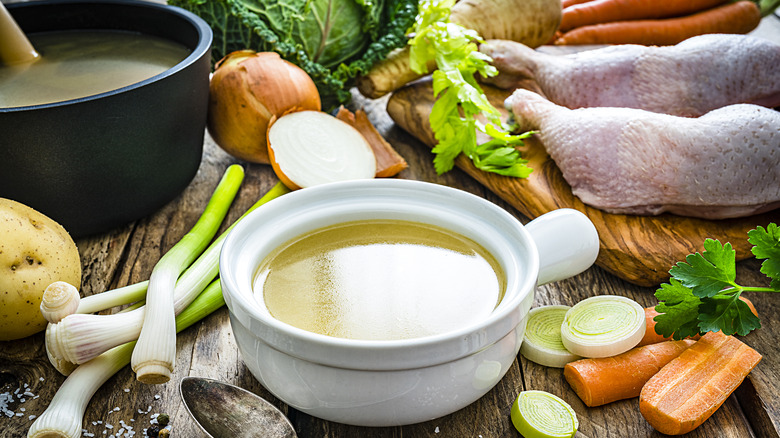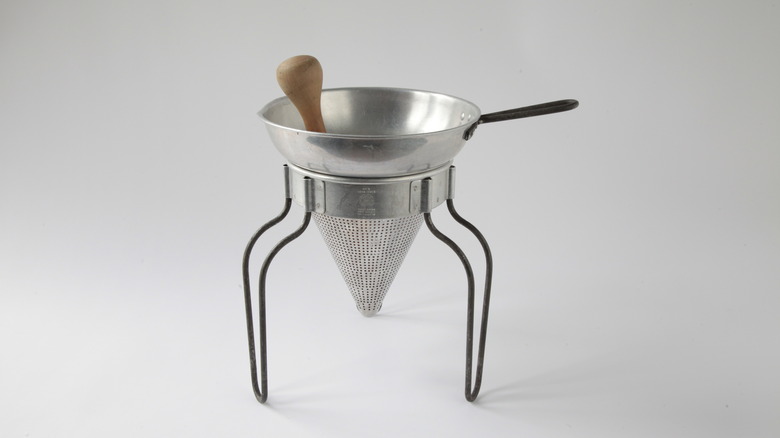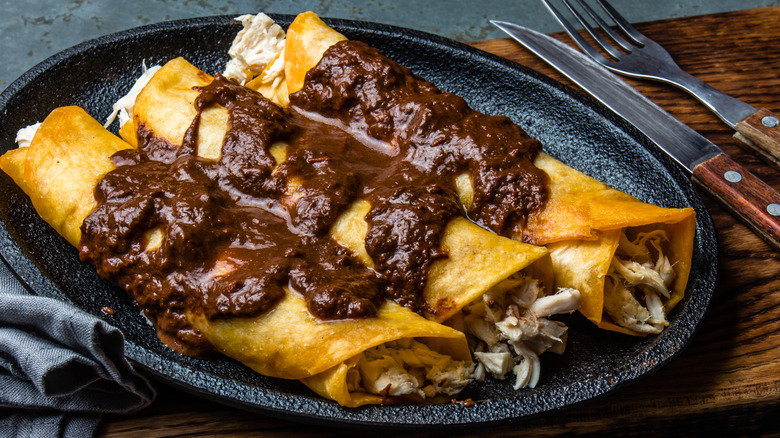12 Tips For Making Incredible Mole From Scratch
Making mole from scratch is a labor of love and can be time-consuming, but the result of this labor is delicious. This rich, complex sauce is both a staple in many Mexican households and a very personal undertaking. Many families have prized recipes with infinite variations in spices and constructions that result in wide-ranging variations across South and Central America.
When the mole is ready, its texture is smooth and velvety, with each of the more than 20 ingredients married nicely by its long simmer and careful layering of flavors. The French might have mother sauces underlying all aspects of their cuisine, but mole is arguably the foundational preparation from which all other Mexican sauces proceed.
If you'd like to try your hand at mole (pronounced MOH-lay), doing a little research first is crucial. This sauce is not too sweet or spicy but has a highly flavored balance of sweet, sour, spicy, and salty. To get it right, here are some tips to guide you through preparing an authentic mole.
What is mole?
The word "mole" is taken from the Mexican word for sauce (molli or mulli). It is labor-intensive and can take hours and sometimes days of careful and patient cooking. The result is a silky-smooth, velvety sauce that is rich, complex, and never runny.
There are as many as 40 different types of mole across Central and South America. Although combinations of spices and chilis vary, each has five specific categories of ingredients in common. Chilis are a common denominator for every mole. It's traditional to include at least two kinds but often half a dozen or more, depending on the recipe. Sour ingredients such as tomatoes, tomatillos, or other sour fruits bring a bit of tangy that offsets richness. Sugar, dried fruit, or liquid sweeteners combat excessive bitterness, and spices are added in endless options and variations. Finally, mole is thickened with different seeds (i.e., sesame or pumpkin), peanuts, or bread.
There are three main types of mole: poblano, negro, and verde. Each has a distinctive flavor profile. Verde is the freshest and spiciest version, with negro being smoky and dark. Mole poblano is faster to make and used as a casual daily culinary staple. There are regional variations that include everything from pineapple to bananas. This is why families have their own sauces, made to incorporate favorite ingredients and tailored to a family's specific tastes.
Mole requires fresh spices
The better the ingredients you start with, the better the final product. Nowhere is this more true than in a sauce as complex as mole. Each component is subjected to a long, slow cook, bringing out more subtle flavors as time goes on. Choosing fresh spices and chilis is essential.
When it comes to spices, if you can grind your own whole spices or seeds, definitely do it. If not, buy fresh spices in bulk. Look for vibrant colors and strong smells; if the scent is mild and the color dull, choose another option.
Dried chilis should be vibrantly colored and flexible. Search for those with shiny skin and a pleasant, rich aroma. They should not be brittle, dull, or odorless. Many supermarkets sell dried chilis, but these may be passed a "best used by" date and thus not as pungent or flavorful.
As for fresh ingredients such as tomatoes, tomatillos, and herbs, use good judgment when selecting these. Flavorless hothouse tomatoes out of season will not produce an intensely flavored sauce. Canned tomatoes are a viable option if making mole in the winter months.
Mix up your chilis
Dried chilies are the star of every mole and make each one different every time you cook. Common choices like ancho, pasilla, and mulato make for a more traditional flavor and are worth seeking out. These and others bring depth, complexity, and heat to the final product.
There are several common chilis. Dried poblano peppers turn into ancho chilis, imparting a smoldering sweetness with medium heat. They are triangular when dried. Pasillo chilies are dried chilaca chilis with dark skin and bitter chocolate and grass notes. When choosing, look for wrinkly skin.
Guajillo chilis are versatile and also used in enchilada sauce. Their skin, when dried, is deep red and shiny, and their shape is long and slightly tapered. Chipotle chilis are fresh jalapeños that have been smoked and dried. Their heat is medium and their flavor is deep and smoky. Drying reduces the fresh element of the jalapeño (some of which may also be added in certain variations of mole).
To balance sweet ingredients with medium heat and a touch of acid, choose cascabel chilis with their distinctive cherry shape and rattling seeds inside. Want to add mild heat and chocolate, licorice, or cherry flavor? Mulato chilis — fully mature poblanos — are a good bet. Keep in mind that mole is not meant to be so hot that it erases your tastebuds on the first bite. Balance is critical here, and it can take some time to figure out which ones you prefer.
Pay attention to detail
All delicious mole begins with paying attention to small details. Yes, you could use jarred ground spices and toss them directly in the pot, but the best mole begins with gently toasting whole seeds before grinding. Traditionalists use a molcajete, a rough-surfaced mortar and pestle, to grind their spices. You could also use a coffee grinder dedicated to this purpose.
Another ingredient that deserves toasting to bring out a more nuanced flavor is any nuts and seeds you use. This includes almonds, peanuts, pumpkin seeds, and sesame seeds.
To toast your seeds and spices before grinding, heat a pan or skillet on medium heat — it should be dry. Add a small quantity of spices and seeds/nuts at a time, and don't overcrowd the pan. Toast, swirling now and then, until the ingredients begin to bloom. The flavors will become more pronounced, and the nuts and seeds may start to color slightly and release some oil. Do not walk away as they toast — these are delicate ingredients that can go from perfect to burnt in seconds. When they are done, remove them from the heat and allow them to cool before grinding.
Choose your chocolate
Chocolate in a savory sauce? Absolutely. Some of the best chili in the U.S. takes its lead from mole, adding chocolate during cooking to add bitterness and rich flavor. While not all mole uses chocolate, this secret ingredient provides another layer to the overall taste profile.
But not all chocolate is suitable for mole — or is it? On the surface, white chocolate seems like a terrible choice. After all, it's not actually chocolate, and the cheapest kinds are basically sugar and oil. But white chocolate is a good option when you want to add sweetness without bitter notes. You'll need to adjust whatever sweetener you add to account for the cloying sweetness of the white chocolate, though.
Milk chocolate is another way to add more flavor and sugar. It's a slightly more traditional choice, but it's still not necessarily what the everyday Mexican household would use. Dark chocolate in many varieties is widely available and an easy pick for cooks in the U.S. It has varying percentages of cacao, ranging from 50% to 100%. The former is sweeter and bitter, and the latter is dry and unsweetened. Both are suitable additions. Mexican chocolate is a popular option for mole negro. Its flavor is rich and filled with tannins. It is not mixed with sugar or conched but is ground with almond and cinnamon for bitter notes that bring more depth.
Use the correct cooking vessel
Mole is traditionally cooked repeatedly in a clay pot reserved especially for this use. A wooden spoon and the pot's walls both add a subtle earthy flavor.
But clay isn't the only way vessel that works. Cast iron is heavy and holds heat. This is a good choice if you like to cook over a wood fire or on top of a wood stove. However, cast iron can react poorly to acidic foods and may impart an off flavor to your mole.
Enameled cast iron solves the problem of reactivity, but it's still heavy. The best enameled cast iron is durable and will last a lifetime but comes with a high price tag. Clad stainless steel is a good solution, too. Stainless steel does not conduct heat well and is not a good option for a long, slow cook. Solve that problem by investing in clad stainless cookware. This combines the exceptional heat conduction of copper inside with stainless steel outside, and the resulting pot can handle longer cooking and still cleans up easily. In general, nonstick cookware is not recommended for this type of cooking. Aluminum, a more affordable option, may react poorly to acids but can be used if no other pots are available. Remove the mole as soon as it is done, and rinse the pot immediately.
Build a more flavorful base
The next foundational ingredient is the stock or broth used to give more volume to your mole. And while boxed stock has come a long way, making your own stock is easy and allows you to have total control of the final flavor of your sauce.
For vegetable stock, fill a large pot with carrots, onions, celery, parsley, leeks, garlic, peppercorns, and salt. You can add vegetable trimmings and scraps from the freezer. Add seasoning herbs like thyme and rosemary if you like, then drop in a few bay leaves. Cover the vegetables with cold water and bring the pot to a boil, reduce the heat, and simmer uncovered for at least one hour. Remove from heat and strain.
For chicken stock, add an entire chicken to the pot, or use leftover bones and scraps, plus the vegetables and water listed above (or any others you'd like to add). Bring to a lazy boil (just a bubble or two breaking the surface), then reduce heat and simmer uncovered for three to four hours. Skim any foam that rises over this time — strain as you would the veggie stock. To make beef stock, roast beef bones, carrots, onion, and celery in a 400-degree Fahrenheit oven for 45 minutes. Scrape bones and veggies into your stockpot (get all of the fat and dried bits from the baking sheet) and add any other vegetables and cover with water. Bring to a boil, then simmer uncovered for five hours.
Sweeten carefully
Mole uses fruit or other sweeteners to balance out the chocolate's bitterness and the chilis' spiciness. The sweetener you choose depends on the flavor you'd like to balance or impart. Raisins are a traditional option that creates a rich and earthy note, and dried currents and golden raisins can be used to further add to the complexity.
Using an assortment of dried fruit in general imparts the concentrated flavor of the dried fruit to your finished product, too. If you use chilis with hints of cherry or dried cherries chopped and added to the sauce before pureeing and adding stock, this adds sweetness along with the tart flavor of the cherry.
It's also an option to balance out the final product with cane sugar, brown sugar, molasses, or honey. Each of these should be added gradually, a tablespoon at a time. Add the sweetener, stir well, then taste to see if more is needed. Remember that you can always add more, but you cannot subtract.
Taste and adjust seasoning
Perfect mole takes time. Mole is not a sauce that can be made for a quick dinner, as it takes hours (and sometimes days). Cook slowly and be patient. As your mole cooks, taste it to make a note of any changes. When you add stock to the mole paste you lovingly and slowly created, the first taste will be a shocking melange of spice, smoke, and bitterness. Do not panic; consider this just the first stage of the process. You will be surprised at how everything changes as it continues to cook.
Set a timer so that you don't continue to fuss over the pot. Taste every 10 to 15 minutes and adjust flavors and seasoning accordingly. This might be dramatic in the beginning, adding more tomatoes, more stock, and additional spice. As cooking time draws to a close, it might be as simple as adding a pinch of salt or a grind of pepper.
Pay attention to texture
The finished mole should be smooth and velvety. It's hard to picture that when you're staring down the barrel of a lumpy sauce studded with bits of spice and chili that escaped the initial grind.
Some cooks argue that it's not traditional, but straining your mole can achieve a velvety texture. This removes any gritty herbs interfering with the sauce's silky passage across the palate. A chinois is an excellent choice for this. This cone-shaped sieve has ultra-fine mesh designed to catch every tiny particle in a finished sauce, soup, or purée. Pour the mole into a chinois positioned over a large bowl and use a pestle, ladle, or the back of a spoon to press the liquid through, extracting as much flavor as possible from the pieces left behind. If you prefer a smooth sauce with a more rustic texture, a handheld sieve with larger mesh works just fine, too. Whichever gauge of mesh you choose, return the mole to the pot when you are finished straining, then taste and adjust the seasoning again as needed.
It can go on everything
Chefs across the globe are redefining how they use mole, designing dishes that highlight the complexity without bogging diners down. The simplest way to eat mole at home is spooned over rice with chicken, beef, or vegetarian protein. You can wrap this up in a tortilla or use the tortilla as a utensil and grab a little bit of each to make a tasty bite.
Mole can also be added to soups for a quick burst of flavor and richness. It's especially delicious in beef stew or chili but adds depth of flavor to any type of soup. Another way to use mole is in a dip. Allow the finished mole to cool, then add sour cream and lime juice to taste. Garnish with chopped cilantro and serve with chips or bread for dipping.
Use mole as the emulsifier in a salad dressing. Combine mole, lime juice, oil, and herbs in a Mason jar and shake to combine. Adjust the taste by adding a drop or two of honey or other spices. Splash over fresh greens or use it to dress cold black bean salad. Finally, indulge your sweet tooth by adding mole to desserts. It makes a delicious ice cream that straddles the sweet/savory line and adds more flavor to brownies. Fill your next layer cake with mole ganache or pipe mole custard into profiteroles and dust with cinnamon-scented powdered sugar for a spicy-sweet treat.
Store extra mole carefully
If you've made an enormous batch of mole and cannot imagine using it all up in a week, you'll need to consider storage. Mole stores well in the freezer for three months and can be canned for even more longevity. Freeze flat in Ziplock bags or in Mason jars (leave ½" of headroom if freezing in jars), or can in a water bath or pressure canner to store for a year or more at room temperature.
If freezer space is at a premium, another option for future batches is to make mole paste and freeze that before adding stock. This means you'll toast and grind nuts, seeds, and spices, then sauté them in fat to make a paste. Stop at that step, and grab ice cube trays. Portion your mole paste into the trays and freeze. You can then pop the cubes into a freezer bag and add one or two to stock, soups, or sauces for a big flavor hit. Note that if you make mole from these cubes, you might need to adjust the level of sweetness and add fresh tomatoes and vegetables to brighten it up once it's defrosted.
